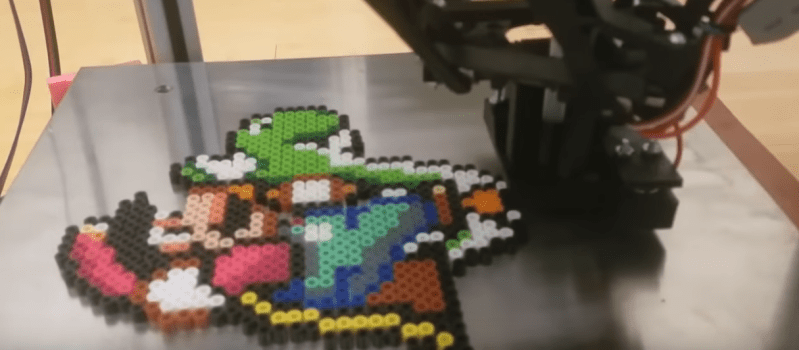There’s something oddly soothing about the practice of laying down Perler Beads on a casual weekend to make your favorite classic Nintendo characters. But seriously, why use our grubby hands like a caveman when we could leverage a machine to do the heavy-lifting for us? That’s exactly what [knezuld11] did! They’ve built a 64-color Bead Sprite Printer including an automatic cooking feature for fusing the result. (Video, embedded below.)
From the top, up to 64 unique bead colors are stashed into cartridges at the top. A bulk agitator does the work of passing these beads into tubes for the lower-stage bead selector. At this level, beads colors are serialized into a single tube that feeds into the output “nozzle.” The entire process of directing the bead pattern is driven by a Python script that takes images as input and approximates their colors to the available bead palette. When the bead “printing” is done, the machine ramps up its heated bed and cooks the bottoms of the beads, fusing them together in a way that [knezuld11] says works actually better than the typical ironing method.
We simply love how feature-complete this system is. While [knezuld11] mentioned that the Bead Sprite Printer was an attempt at beating a world record, we imagine that there are dozens of other ways this machine could lead to some whimsical engagements. Quite frankly, we’d love to see this machine at an Artist Alley making on-demand art.
If you managed to spill all your beads from sheer excitement watching this video, fret not! This automatic bead sorter from our past is just the thing to help you out.

















Imagine a computer vision system as a front end for this to do perler prints on demand in a kiosk
Why computer vision system? Just camera and script which resizes images. BUT i think that could be a neat project…
That is a computer vision system. just a really really simple one.. Unless you are somehow taking a film photograph and without doing any digitizing and processing on that image magically making the print file.
Anything doing post-processing on images with a computer can be considered and accurately described as a computer vision system. You could even argue that just the act of taking a digital photo is a computer vision system.
Camera–> Computer–> output.
Just because its more commonly used to describe the ‘expect immediate results’ on multiple frames per second systems for robot tasks doesn’t make it less correct.
Wauw, amazing! This is really something, I bet a lot of time went to it.
Just added it to my project list(in the top 10 range :) )
Yeah, this is really stunning. I can only begin to imagine the hours in building and debugging all of the steps!
The bead shaker, the pushers, the selector. And then a heated bed to fuse them at the end.
Wow.
“The entire process of directing the bead pattern is driven by a Python script…”
It just seems so wrong that it isn’t done with a Perl script!
Genius! Finally something unique and awesome at the same time. Kudos.
I want starry night!
The next step is to start building upwards, to generate solid models. Some sort of three dimensional printing device, if you can imagine.
Awesome!
I really would like to know costs